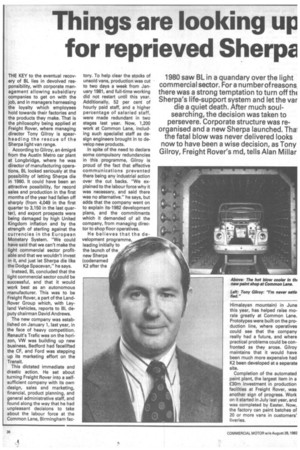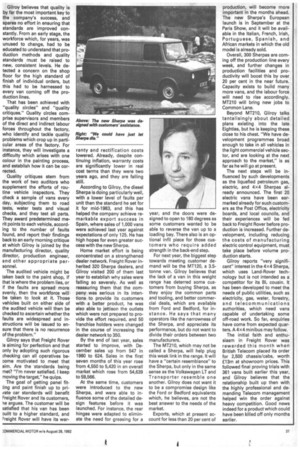Things are looking up for reprieved Sherpa
Page 30

Page 31

If you've noticed an error in this article please click here to report it so we can fix it.
1980 saw BL in a quandary over the light commercial sector. For a numberof reasons, there was a strong temptation to turn off th( Sherpa's life-support system and let the var die a quiet death. After much soulsearching, the decision was taken to persevere. Corporate structure was reorganised and a new Sherpa launched. Thai the fatal blow was never delivered looks now to have been a wise decision, as Tony Gilroy, Freight Rover's md, tells Alan Millar
THE KEY to the eventual recovery of BL lies in devolved responsibility, with corporate management allowing subsidiary companies to get on with the job, and in managers harnessing the loyalty which employees hold towards their factories and the products they make. That is the philosophy being applied at Freight Rover, where managing director Tony Gilroy is spearheading the rescue of the Sherpa light van range.
According to Gilroy, an émigré from the Austin Metro car plant at Longbridge, where he was director of manufacturing operations, BL looked seriously at the possibility of letting Sherpa die in 1980. It could have been an attractive possibility, for record sales and production in the first months of the year had fallen off sharply (from 4,049 in the first quarter to 3,150 in the last quarter), and export prospects were being damaged by high United Kingdom inflation and by the strength of sterling against the currencies in the European Monetary System. "We could have said that we can't make the light commercial sector profitable and that we wouldn't invest in it, and just let Sherpa die like the Dodge Spacevan," he says.
Instead, BL concluded that the light commercial sector could be successful, and that it would work best as an autonomous manufacturer. This was to be Freight Rover, a part of the LandRover Group which, with Leyland Vehicles, reports to BL deputy chairman David Andrews.
The new company was established on January 1, last year, in the face of heavy competition. Renault's Trafic was on the horizon, VW was building up new business, Bedford had facelifted the CF, and Ford was stepping up its marketing effort on the Transit.
This dictated immediate and drastic action. He set about turning Freight Rover into a selfsufficient company with its own design, sales and marketing, financial, product planning, and general administrative staff, and found along the way that he had unpleasant decisions to take about the labour force at the Common Lane, Birmingham fac
tory. To help clear the stocks of unsold vans, production was cut to two days a week from January 1981, and full-time working did not restart until this year. Additionally, 52 per cent of hourly paid staff, and a higher percentage of salaried staff, were made redundant in two stages last year. Now, 1,200 work at Common Lane, including such specialist staff as design engineers brought in to develop new products.
In spite of the need to declare some compulsory redundancies in this programme, Gilroy is proud of the fact that effective communications prevented there being any industrial action over the cut backs. "We explained to the labour force why it was necessary, and said there was no alternative." he says, but adds that the company went on to explain its-1982 development plans, and the commitments which it demanded of all the company, from managing director to shop floor operatives.
He believes that the development programme, leading initially to the launch of the new Sherpa (codenamed K2 after the
Himalayan mountain) in June this year, has helped raise morale greatly at Common Lane. Prototypes were built on the production line, where operatives could see that the company really had a future, and where practical problems could be confronted as they arose. Gilroy maintains that it would have been much more expensive had K2 been developed at a separate site.
Completion of the automated paint plant, the largest item in a £30m investment in production facilities at Freight Rover, was another sign of progress. Work on it started in July last year, and was completed by Easter. Now, the factory can paint batches of 20 or more vans in customers' liveries. Gilroy believes that quality is by far the most important key to the company's success, and spares no effort in ensuring that standards are improved con stantly. From an early stage, the workforce which, for years, was unused to change, had to be educated to understand that pro duction methods and quality standards must be raised to new, consistent levels. He de tected a concern on the shop floor for the high standard of finish of individual orders, but this had to be harnessed to every van coming off the production lines.
That has been achieved with "quality circles" and "quality critiques." Quality circles com prise supervisors and members of the direct and indirect labour forces throughout the factory, who identify and tackle quality problems which crop up in particular areas of the factory. For instance, they will investigate a difficulty which arises with one colour in the painting process, and establish how it can be corrected.
Quality critiques stem from the work of two auditors who supplement the efforts of rou tine vehicle inspectors. They check a sample of vans every day, subjecting them to road tests, water tests and visual checks, and they test all parts.
They award predetermined me rit points to each vehicle, according to the number of faults found, and report their findings back to an early morning critique at which Gilroy is joined by the manufacturing director, quality director, production engineer, and other appropriate personnel.
The audited vehicle might be taken back to the paint shop, if that is where the problem lies, or if the faults are spread more evenly, then the workforce will be taken to look at it. Those vehicles built on either side of the audited vehicle will then be checked to ascertain whether the faults are widespread and instructions will be issued to ensure that there is no recurrence of the problem."
Gilroy says that Freight Rover is aiming for perfection and that only by adopting such rigorous checking can all operatives become motivated to meet that aim. Are the standards being met? "I'm never satisfied. I keep moving the target," he quips.
The goal of getting panel fitting and paint finish up to pri vate car standards will benefit Freight Rover and its customers, he argues. The customer will be iatisfied that his van has been built to a higher standard, and Freight Rover will have its war ranty and rectification costs lowered. Already, despite continuing inflation, warranty costs are significantly lower in real cost terms than they were two years ago, and they are falling still.
According to Gilroy, the diesel Sherpa is doing particularly well, with a lower level of faults per unit than the standard he set for it for mid-1983, and this has helped the company achieve remarkable export success in Spain, where sales of 1,000 vans were achieved last year against expectations of only 125. He has high hopes for even greater success with the new Sherpa.
Home market effort is being concentrated on a strengthened dealer network. Freight Rover inherited 320 Sherpa dealers, and Gilroy visited 200 of them last year to establish why sales were falling so severely. As well as reassuring them that the company was serious in its intentions to provide its customers with a better product, he was also able to jettison the outlets which were not prepared to provide the effort required, and 50 franchise holders were changed in the course of increasing the dealer network to 350.
By the end of last year, sales started to improve, with December sales up from 547 in 1980 to 624. Sales in the first seven months of this year rose from 4,550 to 5,420 in an overall market which rose from 54,639 to 59,566.
At the same time, customers were introduced to the new Sherpa, and were able to influence some of the detailed design features before it was launched. For instance, the rear hinges were adapted to eliminate the need for greasing for a year, and the doors were designed to open to 180 degrees as some customers wanted to be able to reverse the van up to a loading bay. There also is an optional infil piece for those customers who require added strength in the back-end step.
For next year, the biggest step towards meeting customer demand will be the MT120, a 3.5tonne van. Gilroy believes that the lack of a van in this weight range has deterred some customers from buying Sherpa, as they enjoy the common parts and tooling, and better commercial deals, which are available from Ford and Bedford, for instance. He says that many operators like the narrowness of the Sherpa, and appreciate its performance, but do not want to divide their orders between two manufacturers.
The MT210, which may not be called a Sherpa, will help plug this weak link in the range. It will have a "certain resemblance" to the Sherpa, but only in the same sense as the Volkswagen LT and Transporter resemble one another. Gilroy does not want it to be a compromise design like the Ford or Bedford equivalents which, he believes, are not the best answer to the needs of the market.
Exports, which at present account for less than 20 per cent of production, will become more important in the months ahead.
The new Sherpa's European launch is in September at the Paris Show, and it will be avail able in the Italian, French, Irish, Portuguese, Spanish, and African markets in which the old model is already sold.
Overall, 300 Sherpas are coming off the production line every week, and further changes in production facilities and productivity will boost this by over 20 per cent in the near future.
Capacity exists to build many more vans, and the labour force will need to rise accordingly. MT210 will bring new jobs to Common Lane.
Beyond MT210, Gilroy talks tantalisingly about detailed plans existing into the late Eighties, but he is keeping these close to his chest. "We have de velopment programmes broad enough to take in all vehicles in the light commercial vehicle sec tor, and are looking at the next approach to the market," is as far as he will go at present.
The next steps will be influenced by such developments as the liquefied petroleum gas, electric, and 4x4 Sherpas already announced. The first 20 electric vans have been ear marked already for such customers as the Post Office, electricity boards, and local councils, and their experiences will be fed back to Freight Rover before pro duction is increased. Further de velopment, including reducing the costs of manufacturing electric control equipment, must take place before volume production starts.
Gilroy reports "very significant" interest in the 4x4 Sherpa, which uses Land-Rover tech nology but is not intended as a competitor for its BL cousin. It has been developed to meet the needs of public utilities, such as electricity, gas, water, forestry, and telecommunications authorities, which need vans capable of undertaking some off-road work. So far, enquiries have come from expected quarters. A 4x4 minibus may follow.
The initial faith and enthusiasm in Freight Rover was rewarded this month when British Telecom placed its order for 2,500 chassis/cabs, worth £13m at showroom prices. This followed final proving trials with 361 vans built earlier this year, and Gilroy believes that the relationship built up then with the highly professional and de manding Telecom management helped win the order against heavy competition. Good news indeed for a product which could have been killed off only months earlier.








































